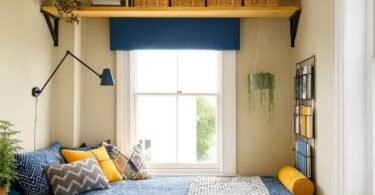Why Your Child’s Room Matters More Than You Think
I’ll be honest with you. When I first became a parent, I thought the nursery was just another room in the house. Boy, was I wrong! After watching my kids grow up and seeing how their spaces shaped their personalities, I’ve learned that a child’s bedroom isn’t just four walls and some furniture. It’s their universe, their sanctuary, and quite frankly, the place where most of their childhood memories get made.
Think about it for a second. Where did you go when you needed to feel safe as a kid? Where did you retreat when the world felt too big and scary? I bet it was your bedroom. That’s exactly why we need to get this right, even when our wallets are screaming “no more spending!”
Your little one spends countless hours in that space. They dream there, play there, and slowly but surely become the person they’re meant to be within those walls. The crazy part? You don’t need to spend a fortune to create something magical. I’ve seen parents drop thousands on designer furniture only to have their kids prefer playing with cardboard boxes. On the flip side, I’ve witnessed incredible transformations happen with nothing more than some paint, creativity, and a weekend’s worth of elbow grease.
The research backs this up too. Child psychologists have been telling us for years that our environment shapes who we become. A thoughtfully designed room can boost creativity, improve sleep quality, and even help with emotional regulation. When we create spaces that feel safe and inspiring, we’re giving our children the foundation they need to grow into confident, happy humans.
Here’s what I find fascinating though. Kids don’t care about brand names or fancy price tags. They care about feeling comfortable, having space to be themselves, and knowing that their parents put thought into creating something special just for them. That’s the secret sauce we’re going for here.
Choosing the Perfect Theme Without Going Overboard
Let me tell you about the theme trap I fell into with my first child. I thought I needed to create some elaborate princess castle complete with custom murals and hand-painted details. Three months and several hundred dollars later, my daughter decided she was actually into dinosaurs. Kids change their minds faster than we change our socks!
The smart approach? Pick themes that can evolve with your child. I’ve learned to think bigger picture. Instead of committing to specific characters that might be out of fashion next month, we focus on broader concepts that have staying power. Nature themes work brilliantly because they’re timeless. Ocean motifs, forest adventures, or space exploration never really go out of style.
Girls often gravitate toward flowers, butterflies, and fairy tale elements, while boys might lean toward superheroes, vehicles, or adventure themes. But here’s the thing that might surprise you: don’t box yourself in with gender stereotypes. I’ve seen boys who absolutely love butterfly decorations and girls who are obsessed with trucks. Let your child’s personality guide the decision, not what society says they should like.
The beauty of working with a limited budget is that it forces creativity. We’ve created amazing themes using nothing more than wall decals, creative paint techniques, and DIY projects. One of my favorite budget wins was a space theme we created using glow-in-the-dark stars (five dollars), black paint for an accent wall (twelve dollars), and some silver spray paint on cardboard to make “spaceship” wall art (another eight dollars). Total cost? Twenty-five bucks for a room that looked like it belonged in a magazine.
Wall decals are your best friend when you’re theme shopping on a budget. They’re removable, affordable, and come in every design you can imagine. Plus, when your child inevitably decides they’re “too old” for their current theme, you can peel them off and start fresh without any permanent damage to the walls.
Smart Material Choices That Won’t Break Your Budget
Here’s something that took me way too long to figure out: the most expensive option isn’t always the best option, especially when it comes to kids’ rooms. Children are basically tiny tornados of destruction, so spending a fortune on materials that can’t handle their energy is just throwing money away.
Let’s talk flooring first because this is where many parents make costly mistakes. Hardwood looks gorgeous, but it’s expensive and shows every scratch and dent. Laminate flooring has become incredibly sophisticated and costs a fraction of real wood. The anti-static properties are a real bonus too, especially during those dry winter months when everything seems to shock you.
Carpet is tricky in kids’ rooms. It’s soft and comfortable, which is great for playtime, but it’s also a magnet for spills, crumbs, and mysterious stains that seem to appear overnight. If you’re going the carpet route, stick to darker colors and patterns that can hide the inevitable accidents. Area rugs are my preferred compromise. They give you that soft surface for play but can be replaced without major expense when they’ve seen better days.
For walls, I’m a huge fan of washable paint. Yes, it costs a bit more upfront, but trust me, you’ll thank yourself later when you can actually clean off those crayon masterpieces instead of having to repaint entire walls. Semi-gloss or satin finishes work well because they’re more durable than flat paint and easier to wipe down.
Vinyl wallpaper might not sound glamorous, but it’s practically indestructible and comes in amazing designs these days. Paper wallpaper looks nice initially, but it doesn’t stand up to the wear and tear of daily kid life. I learned this the hard way when my son decided to “help” decorate by peeling off strips of expensive paper wallpaper I’d just installed.
The key is thinking long-term. That extra ten or twenty dollars you spend on more durable materials upfront will save you hundreds in repairs and replacements down the road. Kids test everything, so choose materials that can handle their enthusiasm.
Creating the Perfect Lighting Without Hiring an Electrician
Lighting in a child’s room needs to work harder than anywhere else in the house. It needs to be bright enough for homework, soft enough for bedtime stories, and flexible enough to handle everything in between. The good news? You can create amazing lighting effects without rewiring your entire house.
Overhead lighting is your foundation, but skip the fancy crystal chandeliers and ornate fixtures. Kids don’t appreciate the aesthetic, and frankly, those delicate pieces are just accidents waiting to happen. A simple flush-mount fixture with a fun shade can provide all the general lighting you need at a fraction of the cost.
Here’s where we get creative. Table lamps are perfect for adding personality and task lighting. Thrift stores are goldmines for unique lamp bases that you can update with new shades. I’ve found some amazing pieces for under ten dollars that looked completely different after a quick spray paint makeover and a new shade.
String lights aren’t just for college dorms anymore. They create the most magical ambiance and cost almost nothing. Drape them around windows, along walls, or even create fun shapes on the ceiling. Battery-operated versions eliminate safety concerns and give you placement flexibility that plug-in lights can’t match.
Night lights deserve special attention because they serve such an important function. Instead of the basic plug-in varieties, look for projector night lights that can display stars, ocean scenes, or other calming images on the ceiling. They’re slightly more expensive than basic night lights but create such a special atmosphere that kids actually look forward to bedtime.
Adjustability is everything in kids’ lighting. Dimmer switches are worth the small investment because they let you customize the mood throughout the day. Bright for play time, medium for homework, and soft for winding down before bed. Your child will sleep better, and you’ll have fewer bedtime battles.
The Psychology of Color in Your Child’s World
Color psychology isn’t just marketing fluff when it comes to kids’ rooms. Colors genuinely affect mood, energy levels, and even sleep quality. The trick is understanding how to use this knowledge without turning your child’s room into a psychology textbook.
Bright, primary colors are exciting and energizing, which explains why so many toys come in red, blue, and yellow. These colors are perfect for play areas, but they can be overstimulating if they dominate the entire room. I’ve seen bedrooms that looked like rainbows exploded, and while they’re certainly colorful, they don’t promote the calm energy you want for sleep.
The secret is balance. Use bright, energetic colors as accents rather than main themes. A navy blue accent wall can make the room feel cozy and sophisticated while still being fun. Green is incredibly versatile because it’s naturally calming but not boring. It works well as both a main color and an accent.
Pink doesn’t have to mean princess overload. Dusty rose or coral can create beautiful, sophisticated spaces that will grow with your daughter. Similarly, blue doesn’t have to scream “boy’s room.” Soft blues, teals, and even navy can work in any child’s space regardless of gender.
Here’s something most parents don’t consider: the psychological impact of the ceiling color. Most people paint ceilings white and call it done, but kids spend a lot of time looking up from their beds. A soft blue ceiling can create the feeling of sky, while darker colors can make the room feel more cozy and enclosed. Stars or clouds on the ceiling turn bedtime into an adventure.
Neutral base colors are your safety net. Beige, gray, or soft white walls give you the flexibility to change accent colors as your child’s preferences evolve. You can completely transform the room’s personality just by swapping out bedding, curtains, and accessories without repainting everything.

Budget-Friendly Furniture Solutions That Actually Work
Furniture shopping for kids’ rooms can either be your biggest expense or your smartest savings opportunity. The key is knowing where to splurge and where to save. Spoiler alert: most of the time, saving is the smarter choice.
Kids outgrow furniture fast. That adorable toddler bed your three-year-old loves will be too small in just a couple of years. Instead of buying furniture for right now, think about pieces that can adapt and grow. Storage ottomans work as seating now and can become footrests later. Adjustable-height desks grow with your child and save you from buying multiple pieces over the years.
Second-hand furniture is where the real bargains hide. Kids don’t care if their dresser is brand new, and you can often find solid wood pieces at thrift stores for less than what you’d pay for particle board furniture at big box stores. A little sanding and paint can transform a tired-looking piece into something that looks custom-made.
DIY furniture projects aren’t as scary as they sound. Simple bookcases, toy storage boxes, and even basic desks can be built with minimal tools and experience. Online tutorials make it possible for complete beginners to create professional-looking pieces. Plus, there’s something special about furniture you built yourself. Your child will treasure those pieces long after they’ve outgrown them.
Modular storage systems are brilliant for kids’ rooms because they adapt to changing needs. Start with a few basic cubes and add more as your storage needs grow. They work for toys now, books later, and eventually clothes or personal items as your child gets older. The initial investment pays off because you’re not constantly replacing storage solutions.
Multi-functional furniture is a budget parent’s best friend. Beds with built-in storage eliminate the need for separate toy boxes. Desks with hutches provide both work space and display areas. Ottoman storage pieces serve as seating, storage, and play surfaces. When every piece of furniture does double duty, you need fewer pieces overall.
Creating Zones Without Building Walls
One of the smartest design strategies for kids’ rooms is creating distinct zones for different activities. Sleep zone, play zone, study zone. It sounds complicated, but it’s actually quite simple and doesn’t require any construction.
Area rugs are the easiest way to define spaces. A soft, colorful rug marks the play area, while a smaller rug near the desk defines the homework zone. The bed area might have a different rug or no rug at all. This visual separation helps kids understand that different areas have different purposes.
Furniture placement does most of the heavy lifting when it comes to zone creation. Position the bed away from the main activity areas to create a sense of separation. The desk should have good natural light, usually near a window. The play area needs floor space and easy access to toy storage.
Lighting plays a huge role in zone definition too. Different areas should have appropriate lighting for their function. Bright task lighting over the desk, soft ambient lighting near the bed, and fun accent lighting in the play area. This doesn’t mean you need separate light switches for everything, just thoughtful placement of different light sources.
Storage solutions help reinforce the zone concept. Books and school supplies near the desk area, toys and games in the play zone, clothes and personal items near the bed. When everything has a designated place, kids naturally start to understand the room’s organization.
Visual cues work wonders for younger children. Different wall colors, posters, or decorations in each zone help them understand the space’s purpose. The study area might have educational posters, while the play area features their artwork or favorite characters. These visual markers make the zones feel distinct even though they’re all in the same room.







Leave a Comment